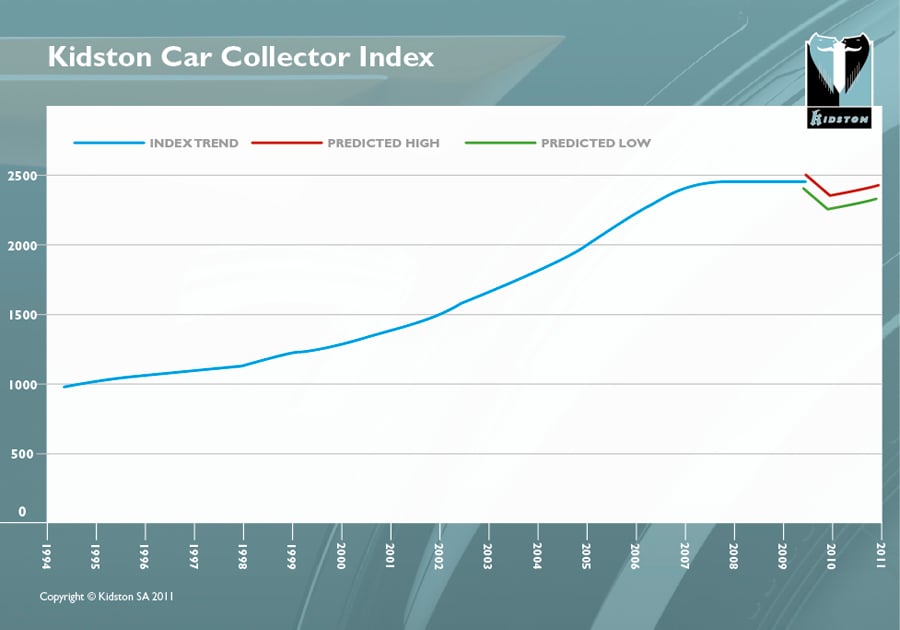
We started last year with the financial markets in turmoil and now we’ve ended it with pundits proclaiming the global economy at its worst since the 1930s, writes Simon Kidston. Yet in the rarefied world of car collecting, records continue to be set, the most exclusive events are still oversubscribed and there seems to be no end to the fresh money pouring into the hobby – whether it comes from banks wishing to lure wealthy collectors as clients, the first car investment funds to appear since 1989, or the highest price ever paid for a car at auction thanks to a mysterious new buyer outbidding a lingerie tycoon eager to get behind the wheel of a 250 Testa Rossa (pictured above with Dan Gurney, not Mr Lingerie) while he's still young enough to enjoy it.
So what’s the reality?
Look below and you’ll find some interesting data. We’ve collated auction prices – public, verifiable and hard to manipulate – of classic cars sold worldwide from 1994 until 2011: over 23,000 transactions in total. Then we’ve isolated the double sales – the same chassis number being sold at least twice – so that we know we’re comparing like-for-like and not, for example, a 'bitsa' to a one-owner 'time warp'. The result is an index which, starting at 1,000 in the summer of 1994, charts the evolution of the classic car market ever since. Take a look:

Some points worth noting:
– Auction prices may differ slightly from private sales (values are often lower) but the trends are likely to be comparable.
– The odd outlying result may cause spikes up or down (such as the bidding battle which produced the first $1.4m steel-bodied Mercedes-Benz Gullwing in Arizona last January) but should be ignored. We'll be refining these in future.
– The number of double sales is limited as we look back over an 18-year period; going forward, the data available and hence the accuracy of any extrapolation will grow.
We then considered what return an investor would have achieved had he put his money in a group of cars representing a cross-section of those sold at auction, regardless of the size of the investment. This is what came out:

Again, what you need to consider:
– Many cars were sold at auction only once between 1994 and 2011, but when they appear again in the future it will strengthen the data and give a clearer picture.
– In both graphs, the double lines leading up to today are a predicted range pending further sales showing both actual data and data adjusted according to existing averages.
What becomes clear in both cases is that the classic car market as a whole has risen steadily rather than spectacularly; in order to achieve the latter, as in most fields of investing, picking the right cars was key. We’ll be publishing more specific data in the near future, for example on Ferrari alone and even individual models, to see how these have fared in comparison to the wider market.
You can see that around 2008 the market softened, picking up in mid-2010 and growing again in 2011, although at a slower pace than the historic average. Opinions will vary as to why, but few onlookers could doubt that the wider economy is a major factor, while owners needing to liquidate cars (and contrary to what the bulls will say, such people do exist) tend to choose auctions as the quickest way to do so, which might account partly for a widening price gap between public and private sales.
Predictions? It’s been said many times before but, as collectors rationalise in times of uncertainty, the gap can only grow between the best and the rest. When anything collectable appears on the market which represents the finest of its kind, has not been offered before, and is unlikely to be easily available again, those who can afford to will step up – even in a downturn. When those criteria aren’t met, the seller needs to be patient, pragmatic and hopefully not proud (although polite helps). And most of what’s offered, despite the rose-tinted spectacles we all wear as owners, falls into the latter category.
Our advice for 2012 is simple: if investment is your motivation, focus on motor cars so exceptional that price is the only thing left to discuss, cars for which there will always be a buyer, even in a downturn... although not necessarily at more than last time (otherwise it would be too easy). And if you just want to have fun behind the wheel, forget all the above and remember that price is not proportional to enjoyment. Happy New Year!
Text: Simon Kidston
Photos: Gooding & Co/Kidston/Classic Driver



